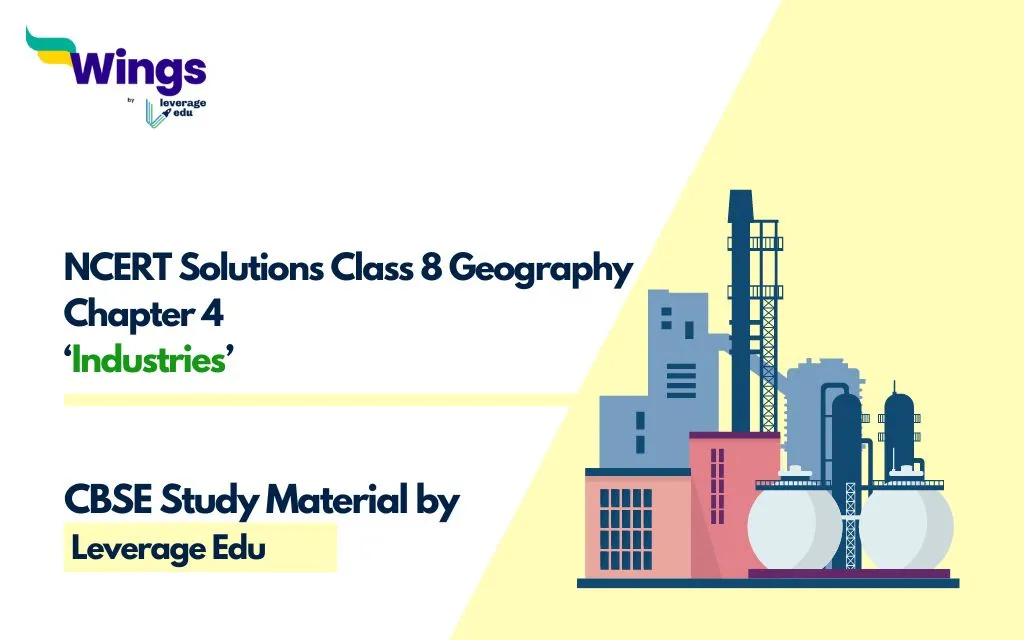We are providing NCERT Solutions Class 8 Geography Chapter 4 Industries to help you navigate through your school exams. You can also download a PDF for important questions and answers for quick revision. This will help you prepare for your school exams. Let us get started!
Download the NCERT Solutions Class 8 Geography Chapter 4 PDF Here!
Download Solutions of all the Chapters of Class 8 Geography:
NCERT Solutions Class 8 Geography Chapter 4 Industries
Here are NCERT Solutions of Class 8 Geography Chapter 4 ‘Industries’ to the questions in the exercise section of the lesson.
1. Answer the following questions.
(i) What is meant by the term ‘industry’?
Answer: An economic activity that is concerned with the production of goods, extraction of minerals or the provision of services, etc is known as an industry.
We have the iron and steel industry (production of goods), coal mining industry (extraction of coal) and tourism industry (service provider).
(ii) Which are the main factors which influence the location of an industry?
Answer: The factors affecting the location of industries are the availability of raw materials, land, water, labour, power, capital, transport and market. Industries are situated where some or all of these factors are easily available. Sometimes, the government provides incentives like subsidised power, lower transport costs and other infrastructure so that industries may be located in backward areas. Industrialisation often leads to the development and growth of towns and cities
(iii) Which industry is often referred to as the backbone of the modern industry and why?
Answer: The Steel industry is often called the backbone of modern industry because almost everything we use is either made of iron or steel or has been made with tools and machinery of these metals. This is a feeder industry whose products are used as raw materials for other industries.
(iv) Why has the cotton textile industry rapidly expanded in Mumbai?
Answer: The cotton textile industry rapidly expanded in Mumbai because of the moist and warm climate, proximity to the port, skilled labour and easy availability of raw materials.
2. Distinguish between the following.
(i) Agro-based and mineral-based industry
Answer: Agro-Based Industries
- They use plant and animal-based products as their raw materials.
- Food processing, vegetable oil, cotton textile, dairy products and leather industries are examples of agro-based industries.
Mineral-based industries
- These are primary industries that use mineral ores as their raw materials.
- The products of these industries feed other industries.
- Iron made from iron ore is the product of mineral-based industry. This is used as raw material for the manufacture of a number of other products, such as heavy machinery, building materials and railway coaches.
(ii) Public sector and joint sector industry
Answer: Public Sector Industry: The public sector industries are owned and operated by the government, such as Hindustan Aeronautics Limited and Steel Authority of India Limited.
Joint Sector Industry: They are owned and operated by the state and individuals or a group of individuals. Maruti Udyog Limited is an example of a joint-sector industry.
3. Give two examples of the following in the space provided :
(i) Raw Materials: _____________ and _____________________
Answer: Iron ore and Cotton
(ii) End products: _______________ and _________________________
Answer: Cloth and Steel
(iii) Tertiary Activities: ________________ and __________
Answer: Banking and Transport
(iv) Agro-based Industries: ____________ and ____________
Answer: Sugar and Dairy
(v) Cottage Industries: ___________ and ________________
Answer: pottery and basket weaving
(vi) Co-operatives: ______________________ and _____________
Answer: Anand Milk Union Limited (Amul) and Mother Dairy
Download the NCERT Solutions Class 8 Geography Chapter 4 PDF Here!
Download Solutions of all the Chapters of Class 8 Geography:
Related Reads:
| What are the Branches of Geography? | Scope of Geography |
| Weavers, Iron Smelters and Factory Owners | A Career in Metallurgical Engineering |
| What is the Full Form of SAIL? | World Nature Conservation Day |
| National Farmers Day | Essay on Agriculture: Short Essay, 100 and 250 Words |
| Indian Agriculture Act 2020: Know all About Farm Laws | When did Agriculture Begin: A Timeline |
| Branches of Soil Science: Definition & Examples | Know all about the Father of Soil Science |
Explore Notes of All subjects of CBSE Class 8:
| CBSE Notes Class 8 English | CBSE Notes Class 8 History | CBSE Notes Class 8 Geography |
| CBSE Notes Class 8 Civics | CBSE Notes Class 8 Mathematics | CBSE Notes Class 8 Science |
FAQs
Ans: An economic activity that is concerned with the production of goods, extraction of minerals or the provision of services, etc is known as an industry.
Ans: The name of Class 8 Geography Chapter 4 is “Industries”.
Ans: It consists of inputs, processes and outputs. The inputs are the raw materials, labour and costs of land, transport, power and other infrastructure. The outputs are the end product and the income earned from it. The processes include a wide range of activities that convert the raw material into finished products. In the case of the textile industry the inputs may be cotton, human labour, factory and transport cost. The processes include ginning, spinning, weaving, dyeing and printing. The output is the shirt you wear.
Follow Leverage Edu for complete study material on CBSE Notes of Class 8 Geography.
 One app for all your study abroad needs
One app for all your study abroad needs














